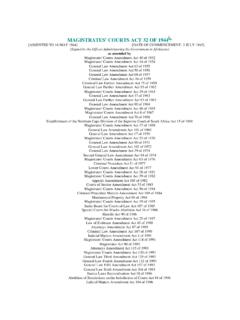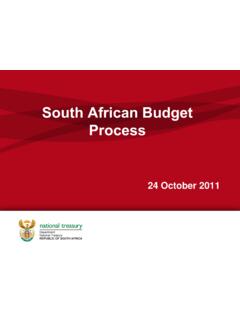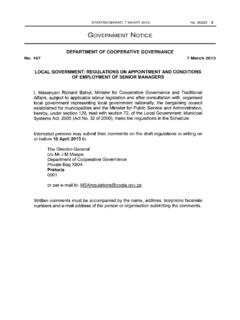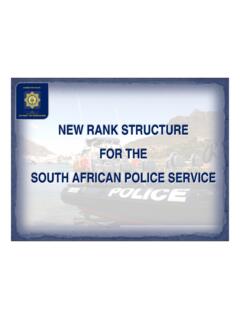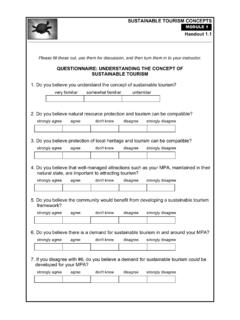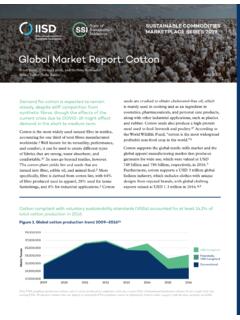Transcription of South Africa’s Trade Policy and Strategy - PMG
1 1 South africa s Trade Policy and Strategy Framework (TPSF): An Update Prepared by: International Trade and Economic Development (ITED) Division Department of Trade and Industry 1 November 2012 2 TABLE OF CONTENTS List of abbreviations and acronyms 3 A. Introduction 4 B. The Changing Global Environment 6 C. South africa s Trade Performance 10 D. South africa s Tariff Policy 20 E. South africa s Trade Strategy : Looking Ahead 23 F. Conclusion 31 3 List of abbreviations and acronyms AGOA africa Growth and Opportunity Act AU African Union BLNS Botswana-Lesotho-Namibia-Swaziland BRIC Brazil-Russia-India-China COMESA Common Market for Eastern and Southern africa DDA Doha Development Agenda EAC East African Community EFTA European free Trade Association EPA Economic Partnership agreement EU European Union FDI foreign direct investment FTA free Trade agreement GDP gross domestic product IMF
2 International Monetary Fund IPAP Industrial Policy Action Plan ITAC International Trade Administration Commission of South africa ITED International Trade and Economic Development LTFR Less-Than-Full-Reciprocity MERCOSUR Mercado Com n del Sur NAFTA North American free Trade agreement NAMA non-agricultural market access NIPF National Industrial Policy Framework NTB non-tariff barrier OECD Organisation for Economic Cooperation and Development PTA Preferential Trade agreement SACU Southern African Customs Union SADC Southern African Development Community SDT Special and Differential Treatment SME small, medium and micro-enterprises TDCA Trade , Development and Cooperation agreement TFTA Tripartite free Trade Area the dti Department of Trade and Industry TIDCA Trade , Investment.
3 Development and Cooperation agreement TIFA Trade and Investment Framework agreement TPSF Trade Policy and Strategy Framework UNCTAD United Nations Conference on Trade and Development US United States of America WTO World Trade Organisation 4 A. Introduction 1. South africa s economic development Strategy , outlined in the New Growth Path (NGP), aims to accelerate growth along a path that generates sustainable, decent jobs in order to reduce the poverty and the extreme inequalities that characterise our society and economy.
4 The NGP identifies infrastructure development, tourism, agriculture, mining, manufacturing and the green economy as the main job drivers for South africa . The National Industrial Policy Framework (NIPF), implemented through the Industrial Policy Action Plan (IPAP), is a central component of this Strategy . The NIPF and IPAP seek to encourage and upgrade value-added, labour-absorbing industrial production, and diversify the economy away from a current over-reliance on commodities and non-tradable services.
5 Employment growth will draw marginalised people and regions of the country into the mainstream of the industrial economy. 3. In the State of the Nation Address in February 2012, President Jacob Zuma announced the launch of a massive infrastructure development programme for South africa . Moving off healthy government finances, the 2012 Budget Speech provided details to the shift in the emphasis of government spending from consumption to investment. More than 17 major infrastructure development programmes are underway, with particular focus on improving transport infrastructure (such as road, rail and ports) and addressing other transport-related Policy issues.
6 These infrastructure investments will underpin and build South africa s industrial base, improve our export capacity and enhance the country s competitiveness. 3. As a comparatively small but open economy in global terms, South africa accounts for only of world Trade . However, international Trade is important for South africa s growth and development, with Trade in goods and services contributing about 60% of gross domestic product (GDP). Import growth in South africa tends to outstrip exports, resulting in a Trade deficit that is financed by portfolio investment, the volatility of which remains a source of macroeconomic vulnerability.
7 South africa will need to accelerate its export growth to address this shortfall and to keep pace with comparable developing countries. A second weakness relates to South africa s continued over-reliance on commodity and resource-based manufactured exports. South africa s under-performance in high value-added exports, which can support Government s employment creation and industrial development objectives, should also be addressed. In addition, there is growing recognition that a competitive and stable currency to support the domestic manufacturing sector and exports is essential.
8 4. South africa s Trade Policy and Trade Strategy must support the country s industrial development objectives. In 2010, the dti prepared the South African Trade Policy and Strategy Framework (TPSF 2010), which was endorsed by Cabinet in July 2010. The TPSF 2010 sets out how Trade Policy and Trade Strategy can contribute to the economic development objectives of Government. The Framework was the outcome of an extensive and intensive three-year review undertaken in consultation with other government departments, Policy experts, Parliament, business and labour.
9 The process was convened and given Policy and political oversight by the Minister of Trade and Industry, Dr Rob 5 Davies. The TPSF 2010 thus reflected the widest national consensus in respect of South African Trade Policy . As such, the TPSF 2010 should be read in conjunction with the TPSF 2012. Importantly, work initiated under the TPSF 2010 to more systematically address Trade in services and other new generation Trade issues (such as the relationship between Trade and competition Policy ) is ongoing.
10 The work on services aims to improve data and statistics, especially on services Trade , and take into account and promote value-added exports such as tourism. 5. The purpose of the TPSF 2012 is thus threefold, namely to: (i) highlight recent global Trade and investment developments, including the lingering impact of the 2008-2010 Great Recession ; (ii) update Trade data for the period 2000 to 2011; and (iii) update key Policy positions set out in 2010. The TPSF 2012 does not purport to provide a comprehensive review of South africa s Trade Policy since 2010 or address the relationship between Trade Policy and other dimensions of economic Policy , such as the exchange rate, labour market and skills, transport Policy and logistics, innovation and technology, productivity, etc.





